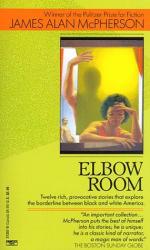|
This section contains 721 words (approx. 2 pages at 400 words per page) |

|
Elbow Room Summary & Study Guide Description
Elbow Room Summary & Study Guide includes comprehensive information and analysis to help you understand the book. This study guide contains the following sections:
This detailed literature summary also contains Topics for Discussion and a Free Quiz on Elbow Room by James Alan McPherson.
Elbow Room is an anthology of twelve independent and unrelated stories about the experience of diverse groups of black Americans.
"Why I like Country Music" portrays a loving married couple sparring about the legitimacy of square dancing as a valid art form, using it as a symbol for radically differing worldviews coming from upbringings in the North and South. The husband tells about a fourth grade crush that results in him besting the class know-it-all to square-dance with the girl on May Day, and to this day, the scent of lemon and the sound of country music remind him of those heady days.
"The Story of a Dead Man" is about the family loyalty one straight-as-an-arrow cousin feels for another, an accomplished liar hell-bent on finding an exciting death. The narrator, William, feels obliged to set the record straight. The story sketches how their lives diverge and comes to a head as he introduces the cousin to his upscale future in-laws, with disastrous results. In the end, the cousins' family loyalty prevails.
"The Silver Bullet" looks at a small street gang and a crooked community activist competing to shake down a bar everyone assumes is protected by the rackets. In the end, all of the toughs get the spanking their mommas should have given them, and the bar owner scoffs at the idea blacks must join the mob to stand up for themselves.
"The Faithful" pits stubbornness with practicality in an age of changing hairstyles and religion. The two strands are united in a single figure that seems determined to fail in both his ventures, as he refuses both to offer Afro hairstyling and preach with the power the people want to hear.
"Problems of Art" deals with the fate of blacks in a white-controlled judicial system, as a black widow charged with DUI hires a white attorney to get across her complex story to a white judge, who she knows will want to hear only facts, not circumstances. Because the black complaining officer shows assumes her guilt and violates the statute, it is suggested she will keep her license, but clear she had indeed been drinking on the night in question, as is her habit.
"The Story of a Scar" examines love, ambition, and jealousy as a once-beautiful black women tells a fellow patient in a doctor's waiting room how she comes to be disfigured by a fellow postal worker and ex-boyfriend's knife. The woman at several points straightens the narrator out on how women think and how men ought to think about women. He submits silently to the powerful woman's opinion, but shows he truly gets the point when, at the end of the story, he finally asks her name.
"I Am an American" takes a black couple out of their milieu in Atlanta, GA, and makes them American tourists in London, caught up in helping two Japanese students report the theft of their money and passports.
"Widows and Orphans" examines the prosperous layer of the black community in Los Angeles as a lecherous college teacher recalls his failed romance with his former student and ex-fiancye, who is receiving civic honor at a banquet. The main action examines the teacher's lustful thoughts about her, bringing him to realize he still loves her, but she introduces him as a former teacher.
"A Loaf of Bread" examines the economics and psychology of white businesses operating in black neighborhoods. The leader of an ad hoc strike and the storeowner cannot put themselves in the other's shoes until the owner's wife demands he give away anything people want for a day, and mobs clean his shelves inside thirty minutes.
"Just Enough for the City" shows how various sects proselytize a predominantly black neighbor and their frustration when confronting someone who will not accept dry, facile answers about the meaning of love.
"Elbow Room" Analysis addresses race openly as an unorthodox writer tells the story of a mixed-race couple whose parents both resist the union. The philosophical white husband struggles to define "nigger," which his well-traveled and open-minded wife wears as a badge of honor. The question comes down to the uncomfortable choice of having their baby be white and blind or black and self-blinded, but the better situation would be having a world where everyone is appreciated and embraced.
Read more from the Study Guide
|
This section contains 721 words (approx. 2 pages at 400 words per page) |

|



